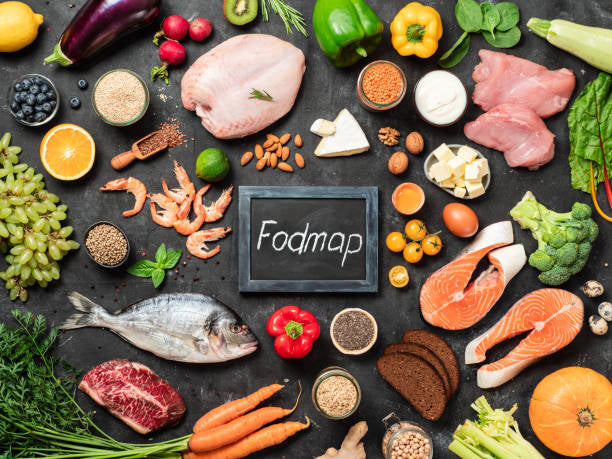The Low FODMAP Diet and Our Meals
Information on low FODMAP diet, our meals and their certification by Monash University.


What are FODMAPS?
FODMAPs are a group of carbohydrates (sugars) found in various foods. Unlike other carbohydrates, they are poorly absorbed in the gut. This can trigger symptoms like gas, bloating and pain in people with irritable bowel syndrome (IBS).
What is a low FODMAP diet?
A low FODMAP diet is a type of elimination diet that can improve IBS symptoms. It involves reducing the amount of FODMAPs you eat for 2-6 weeks by swapping high FODMAP foods for low FODMAP alternatives.
If IBS symptoms improve on a low FODMAP diet, it's likely that you are sensitive to FODMAPs. The next step is to follow FODMAP reintroduction, which helps figure out which FODMAPs you’re sensitive to and in what amounts. You can read more about a low FODMAP diet here.
How are your low FODMAP meals developed?
Each of our low FODMAP meals are designed by our in-house by our chef Matt and FODMAP trained Dietitian. They use the latest low FODMAP information from Monash along with their knowledge about nutrition and taste to do this.
Like all our meals, our low FODMAP range is designed to meet healthy eating guidelines. This means the meals are never high in saturated fat or salt, and have a focus on healthy fats, lean protein and plenty of plant-based foods.
Once developed, our FODMAP meals undergo analysis by the team at Monash University for the different types of FODMAPs. Once confirmed as low FODMAP they receive certification and go into production.
How can I be confident that your meals are low FODMAP?
Each of our low FODMAP meals have been certified as low FODMAP by the experts at Monash University when eating a single serving (one meal).
If you’re planning on eating more than one meal a day, leave 3-4 hours between meals. So, for example, you can eat one of our low FODMAP meals at lunch and another at dinner.
What do you do when the FODMAP content of a food changes?
Monash constantly re-test foods that were originally tested some years ago to check that the FODMAP content has not changed. This is because changes in farming, food production and environmental factors can influence FODMAPs in food.
As a result, Monash regularly publishes updates to the serving sizes of food considered low FODMAP. When this happens, we review our low FODMAP meals in line with this new information and adjust our recipes to ensure that our meals stay low FODMAP.
I’ve seen an ingredient in your meals that isn’t low FODMAP, why is this?
Although foods are often thought of as either being ‘high FODMAP’ or ‘low FODMAP it’s the serving size of a food that determines whether it can be included.
This is because foods contain FODMAPs in varying amounts. Some foods contain very concentrated levels of FODMAPs (garlic is an example) so eating even a tiny amount can trigger symptoms.
Other foods contain much lower concentrations of FODMAPs. These foods can often be eaten in small or medium portion sizes and remain low FODMAP.
Let’s take tinned tomatoes as an example. A ½ cup portion (about 100 grams or a quarter of a can) is low in FODMAPs and can be included in a meal. But a large serving (a cup or half a can) becomes high in the FODMAP fructose, which may trigger symptoms.
If you see an ingredient you think of as high FODMAP in one of our meals, rest assured it’s included in a portion size that ensures the meal stays low FODMAP.
Why do you use peas, beans and lentils in your low FODMAP meals, I thought these were high FODMAP?
Beans, peas and lentils are often avoided by people with IBS as they are high in two types of FODMAP - galacto-oligosaccharides (GOS) and fructans. But you can include most beans peas and lentils on a low FODMAP diet in small portions.
An example is chickpeas – a quarter cup of canned and rinsed chickpeas (about 40 grams) is a low FODMAP serving.
We choose to include peas, beans and lentils in our meals in low FODMAP quantities because they’re a brilliant source of beneficial nutrients like protein, fibre and prebiotics.
Prebiotics are a specific type of fibre that feed beneficial bacteria in the gut, which in turn can have positive effects on health. A low FODMAP diet restricts intake of prebiotic fibre which is one of the reasons it’s not a lifelong diet.
Including prebiotic-rich foods like pulses and nuts in low FODMAP portion sizes means you can benefit from these fibres without triggering symptoms.
Will I end up FODMAP stacking if I eat more than one of your meals a day?
FODMAP stacking refers to the possibility of FODMAPs stacking up in the gut and causing symptoms. This can potentially happen when eating multiple ‘green servings’ of foods in one meal, or if eating meals and snacks very close together.
The best way to avoid stacking is to leave 3-4 hours between meals and snacks. This allows time for food to be digested and slows down the rate at which the gut is exposed to FODMAPs. So, for example, you could eat one of our low FODMAP meals at lunch and another at dinner.
Everyone has a different threshold for FODMAPs, so if your symptoms are well controlled then you don’t need to worry about FODMAP stacking.
If you’re following a low FODMAP diet and not getting good symptom control, talk to your dietitian about stacking.
I experienced symptoms after eating one of your low FODMAP meals, why does this happen if they are low FODMAP?
There are a few possible reasons. If you experienced symptoms soon after eating (within an hour or less), it's unlikely these symptoms are down to the meal you’ve just eaten.
That’s because foods tend to trigger symptoms when they reach the small and large intestine, and it usually takes several hours for this to happen.
It’s worth thinking about the previous meal you ate, or other non-FODMAP triggers that might be affecting your gut. These include caffeine, alcohol, stress or an exaggerated gastro-colic reflex.
If you're experiencing symptoms a few hours after eating, it could be down to the fibre content of the meal. Eating more fibre than usual can increase symptoms, because it provides food for gut bacteria who produce gas when they break fibre down.
Some of our meals are high in fibre. If you are used to a lower fibre diet (which may happen because of trying to control symptoms) you might experience some symptoms as your gut adjusts.
If this resonates, you might find it helpful to start off with these options which are the lower fibre options in the range:
Piri Piri chicken





